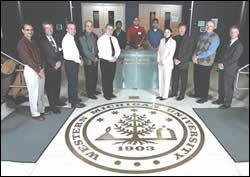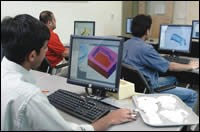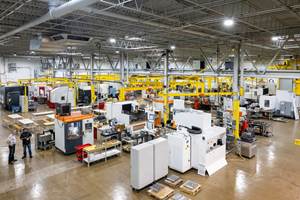Western Michigan University: Manufacturing Today's Engineers
A solid engineering curriculum coupled with strong industry support more than prepares mold designers and machinists for a career in moldmaking.
The manufacturing engineering degree program at Western Michigan University (WMU, Kalamazoo, MI)—started a decade ago as a cooperative venture between local industry in the Muskegon region and the College of Engineering at WMU—was initially designed to simultaneously serve students in the region who may not have been able to leave the area to attend college and to provide a local source of manufacturing talent to companies. In 10 short years the program has evolved into a win-win situation for both groups as this school helps to mold the next generation of tool design engineers and CNC machinists.
According to David Meade, Ph.D., assistant professor, Department of Manufacturing Engineering, this program fills an important niche—made evident by the support from local industry toward their employees who are students in the program. "The format of the MfgE program allows promising employees of these companies the opportunity to acquire the skills and credentials needed to advance within their companies while continuing to work full-time during the day," Meade says. "The students are thankful for the opportunity to achieve a bachelor's degree in engineering while continuing to meet the other demands of life—like supporting themselves or a family. The students also realize the added benefit of being able to earn a B.S. in engineering from a university that is nationally recognized as one of the top 100 public universities in the U.S. As junior engineers or technicians in their companies, they realize the impact that strong credentials can have on their future mobility in their current situation or at another company elsewhere in the U.S. or internationally."
Program Evolution
Ten years ago, a number of local businesses—Howmet, Shape, General Dynamics and Dana—worked with WMU to develop this program, forming an industrial advisory committee called the World Class Manufacturing Council (WCM). The WCM worked directly with the Dean of the College of Engineering and Applied Science, Leonard Lambertson, to configure a Bachelor of Science degree (BSE) in manufacturing engineering.
"The program is configured to work in cooperation with Muskegon Community College (MCC)," Chair of Manufacturing Engineering John Patten explains. "The students attend their first two years at MCC and then matriculate to WMU to complete their BSE degree. While enrolled at MCC the students are classified as pre-engineering candidates. Once the students have completed their lower level coursework at MCC, they seamlessly continue their education at WMU toward their degree requirements.
"Funding for the program initially was supported with a generous contribution from the WCM council," he continues. "A Manufacturing Engineering Foundation account was established with these funds, and this money is used to augment university funds to supply additional resources to enhance the program. WMU funds the program through its continuing/distance education operation, Extended University Programs (EUP)."
Distinct Curriculum
Patten explains that the Manufacturing Engineering degree and program are unique in two distinctive components. "First, it is the only undergraduate degree program offered at a distance education site/center at WMU (all other undergraduate programs at located at the main engineering campus in Kalamazoo)," he notes. "Second, the manufacturing engineering program was established as an evening program to serve the needs of industry and working students (it is the only undergraduate engineering program at WMU that is offered as an evening program). It is possible for a student (taking a full course load, and attending classes year around) to complete the degree requirements in four to five years."
Currently 60 to 65 students are enrolled in the program, which includes a new contingency of students at the college's Battle Creek site. Ten to 15 students graduate per year. "The Battle Creek program—which is identical in format and programming to the Muskegon program—was initiated within the past couple of years to again serve the local region and industries," Patten states. "It is a cooperative program with Kellogg Community College (KCC), although there are some differences between the two locations. Because of the two EUP sites (Muskegon and Battle Creek) and WMU's campuses in Kalamazoo (main campus and Parkview [Engineering] campus), the opportunities for distance education—via compressed video over the internet (CVIT)—and web-based instruction are routinely utilized to augment live, in-class teaching. Other courses are offered via a combination of traditional lecture, laboratory instruction, and web/internet augmented delivery."
Patten notes that enrollment in the program has steadily increased over the years, leading to its largest graduation class in 2004 (the last full year of data available). "This steady increase can be directly attributed to the need for these graduates and the continued support of local industry," he states. "Opportunities for employment, full-time (permanent, co-op and intern) and part-time are readily available. Our students and graduates have complete access to all university support services, including job placement (full time and part time, permanent and temporary, including co-op and internships) through the university and college's career services programs."
Receiving Aid
Recently, WMU's manufacturing engineering department entered into a partnership with Cimatron Technologies, Inc. (Novi, MI) to provide state-of-the-art, high performance design tools to its students. Cimatron donated site licenses to all three of the existing engineering sites. "This software donation has been used at all three locations during the past academic year in three separate courses (CAD/CAM and CNC courses)," Patten says. "This fall we plan to use it in our Tool Design course.
"WMU's Manufacturing Engineering Department, along with Cimatron, has recently joined a group of moldmaking companies to provide education and service to the industry," he adds. "Future joint programs, in cooperation with the Michigan Technology Education Centers (M-TEC) will be focused on training and use of productivity tools for the tool and die/moldmaking industry to increase productivity and reduce costs."
Most of the school's current supplemental funding (for equip-ment, laboratories, etc.) comes from donations, grants and con-tracts, Patten adds. In addition to Cimatron, other companies and organizations also contribute financially to the department and program—such as the National Science Foundation (NSF) and individual companies.
Expansion Underway
Patten would like to develop and grow the research program within the department in cooperation with WMU's Manufacturing Research Center (MRC); engage high school students, parents teachers and counselors to consider manufacturing engineering as a viable career; continue to expand the course offerings for web/internet-based courses; and evaluate the potential to offer pre-engineering curriculum to service other degree programs (mechanical, industrial, electrical engineering, etc.).
Long-term goals include applying for and receiving national accreditation by the Accreditation Board for Engineering and Technology (ABET); evaluating the potential to expand the program to other geographic areas; offering a fully integrated online complement of courses to meet the BSE degree requirements; and augmenting the current manufacturing engineering program offering with other engineering programs.
These short and long-term goals clearly reflect WMU's commitment to the industries it serves. "At the end of the students' formal education culminating in a BSE degree, industry must be satisfied with the quality of the education that the students receive to hire our graduates as full-time, permanent employees in positions as manufacturing engineers," Patten affirms. "Currently, we have more demand for our graduates than we have students to fill the jobs; this is a strong indication that we are doing the right thing by industry. Growth of the program—in terms of student enrollment (headcount) and faculty—is necessary for long term sustainability. We hope to grow the department to about 250 students (enrollment) over the next five years. This would create a critical mass to carry the program forward and ensure its success and viability."
Related Content
Hands-on Workshop Teaches Mold Maintenance Process
Intensive workshop teaches the process of mold maintenance to help put an end to the firefighting culture of many toolrooms.
Read MoreCross Training, In-House Capabilities and Collaborative Design Move Helm Tool Forward
Cross-training, bringing it all in-house, molding and collaborative design are essential to Helm Tool's success.
Read MoreHow to Improve Your Current Efficiency Rate
An alternative approach to taking on more EDM-intensive work when technology and personnel investment is not an option.
Read MoreTackling a Mold Designer Shortage
Survey findings reveal a shortage of skilled mold designers and engineers in the moldmaking community, calling for intervention through educational programs and exploration of training alternatives while seeking input from those who have addressed the issue successfully.
Read MoreRead Next
Are You a Moldmaker Considering 3D Printing? Consider the 3D Printing Workshop at NPE2024
Presentations will cover 3D printing for mold tooling, material innovation, product development, bridge production and full-scale, high-volume additive manufacturing.
Read MoreHow to Use Continuing Education to Remain Competitive in Moldmaking
Continued training helps moldmakers make tooling decisions and properly use the latest cutting tool to efficiently machine high-quality molds.
Read More
























